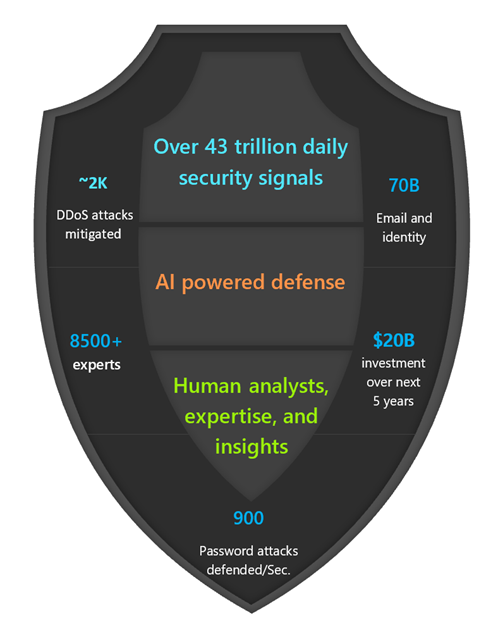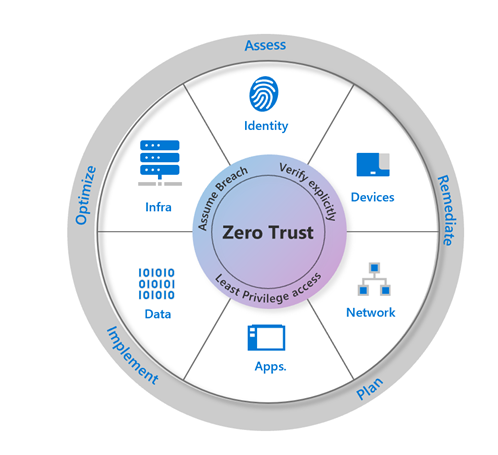
Modernizing Cybersecurity in Public Finance Organizations
Worldwide Public Sector Security Lead Alvaro Vitta details the two major Cybersecurity forces affecting Public Finance Organizations and actions they can take to Modernize their Cybersecurity capabilities.
Modernizing Cybersecurity in Public Finance Organizations
Two major forces are driving the speed, innovation, scale, and growth of cyberattacks against Public Finance organizations. The first one is money. Cybercrime continues to rise as the industrialization of the cybercrime economy lowers the skill barrier to entry by providing greater access to tools and infrastructure for criminals. The second is increased socio-political disruption as demonstrated with Russia’s war in Ukraine. Nation state actors are launching increasingly sophisticated cyberattacks to evade detection and advance their strategic priorities. Outside of Ukraine, Microsoft detected Russian network intrusion efforts against 128 organizations in 42 countries between late February and June 2022. Top sectors targeted included Government agencies, non-governmental organizations, education institutions and financial services, which received 47% of activity. Increases in activity were particularly notable against NATO members.
Impact of cyberattacks on Public Finance organizations
As a result of these forces, Public Finance organizations are being targeted, disrupting revenue collection streams and revenue distribution capabilities while eroding citizens’ trust in their public service institutions. These cyberattacks are happening across the planet in Europe, Asia, Australia, Africa, North America, and Latin America.
Let’s look at an example of a cyberattack against a Public Finance organization to better understand organizational impacts and downstream effects.
If a Public Finance organization receives a ransomware attack this may affect one or all these areas:
- Tax collection systems
- Distribution of funds
- Import and export trade systems may come to a complete stop
- Private identifiable data could be exposed and compromised
If any of those fundamental functions are compromised, the downstream effects can be significant. Including:
- Inability to pay public sector employees and contractors
- Inability to distribute pension and benefit payments
- Disruption to collection of tax and customs revenues
- Exposure or loss of sensitive data
- Public protests begin due to failure of public systems
- Loss of confidence in government operations and public unrest
As the cyberattack scenario above details, Public Finance institutions face clear economic and socio-political threats that directly affect the safety, wellbeing, and stability of national governments worldwide.
Cybercriminals and nation state actors have evolved their tactics, speed, and scale
Cybercriminals continue to act as sophisticated profit enterprises by optimizing their operations and adapting and finding new ways to implement their techniques and to operationalize large scale attacks.
Similarly, nation state actors have increased their sophistication by using advancements in automation, infrastructure, and remote access technologies to attack a wider set of targets.
The volume of password attacks has risen to an estimated 921 attacks every second – a 74% increase in just one year. – 2022 Microsoft Digital Defense Report
Why are Public Finance organizations not prepared to deal with modern cyberattacks?
Over 80% of security incidents can be traced to a few missing elements that could be addressed through modern security approaches.
There are four major factors contributing to the continuing high success ratio of cyberattacks against Public Finance organizations:
-
Legacy Technology: Using siloed stand-alone security technologies made for an on-premises world in the cloud era.
Actionable Recommendation
Leverage a hyperscale, integrated, AI-driven Public Cloud Security platform that can provide you with multi-cloud, hybrid and on-premise capabilities across your multi-platform environment.
-
Legacy Security Approach: Using legacy IT-centric models and treating security as technical overhead as opposed to using modern security frameworks and treating security as a foundational organizational risk mitigation function.
Actionable Recommendation
Implement Zero trust framework as an organizational philosophy and not just as a technical implementation.
-
Skills Gap and Budget Priority: Inability to hire and retain cybersecurity talent and not allocating sufficient budget for security modernization and innovation.
Actionable Recommendation
Make it appealing for cybersecurity talent to want to come and stay in your organization by: modernizing your security infrastructure and tooling; creating innovative labs to do research; rotate them in different security functions to build skills; and keep them challenged and invest in their security skills training.
-
Legacy Mindset: Lack of understanding of the cybersecurity risks of the status quo can slow or prevent actions to address these risks. Lack of insight into the security features of modern cloud-based systems can lead to implementation of security through obscurity models (air-gapped, disconnected systems) or equation of sovereignty or residency to security, without addressing core cyberattack vulnerabilities.
Actionable Recommendation
Cybercriminals and nation state actors are using AI, automation, and modern approaches to carry out their attacks at scale while continuously innovating their methodology. By using modern technology to provide security, Public Finance organizations can level the playing field in order to defend against sophisticated attack frameworks.
Public Finance Organizations need to address these four key factors to defend against the scale, persistence and innovation of cybercriminals and nation state actors.
Microsoft can help Public Finance organizations level the playing field

Over 43 trillion daily security signals assessed
- AI powered defense
- Human analysts, expertise, and insights
- 8500+ experts
- $20B investment over next 5 years
Resulting in hyperscale attack mitigation of:
- ~2K DDoS attacks mitigated per day
- 70B Email and identity threats blocked in 2022
- 900 Password attacks defended per second
Microsoft Helps Level the Playing Field
Microsoft has the people, technology, infrastructure, scale and automation to help Public Finance organizations level the playing field and defend against modern cybercriminals and nation state actors.
Modernizing Your Security Approach in Public Finance
‘Zero Trust’ is a proactive, integrated approach to security across all layers of the digital estate that explicitly and continuously verifies every transaction, asserts least privilege, and relies on intelligence, advanced detection, and real-time response to respond to threats.
The approach to implementing zero trust is an ongoing cycle that continuously needs to be measured and optimized.
- Assesses your Current Zero Trust Posture
- Prioritize focus areas to remediate short-term risk
- Plan Zero Trust transformation roadmap for mid-term and long-term maturity goals
- Implement Zero Trust transformation roadmap using an agile methodology
- Continuously measure and optimize Zero Trust security posture
Learn how to implement Zero Trust in your public sector organization

Conclusion
Cybercriminals and nation state actors are relentlessly continuing to evolve the cyberattack methods and leverage AI, automation, and innovation to continue to attack Public Finance organizations.
Public organizations need to modernize their security systems, their security approach and modernize their mindset to adapt to these threats and build cyber resilience. Over 80% of security incidents can be traced to a few missing elements that could be addressed through modern security approaches. The adoption of best practice approaches like Microsoft’s Intelligent Cloud Security Platform can help Public Finance organizations level the playing field so that they can continue to provide modern critical services to their systems while ensuring the economic safety and protecting the quality of life of their citizens.
Actionable Steps to Start your Zero Trust Journey
- Check where you are today Zero Trust Assessment Tool
- Plan your Zero Trust journey with Zero Trust Business Plan
- Start or optimize your journey with Microsoft Security Services for Enterprise and Microsoft Partners apps
To find out more:
Episode 36: Cyber Resilience in Government
Episode 37: Military Lessons on Cyberdefense
Episode 38: Cybersecurity, Compliance and Cloud: Lessons from Singapore
Government of Nunavut comes back stronger after ransomware attack with Microsoft security solutions
About the Center of Expertise
Microsoft’s Public Sector Center of Expertise brings together thought leadership and research relating to digital transformation in the public sector. The Center of Expertise highlights the efforts and success stories of public servants around the globe, while fostering a community of decision makers with a variety of resources from podcasts and webinars to white papers and new research. Join us as we discover and share the learnings and achievements of public sector communities.
Questions or suggestions?



